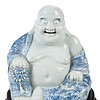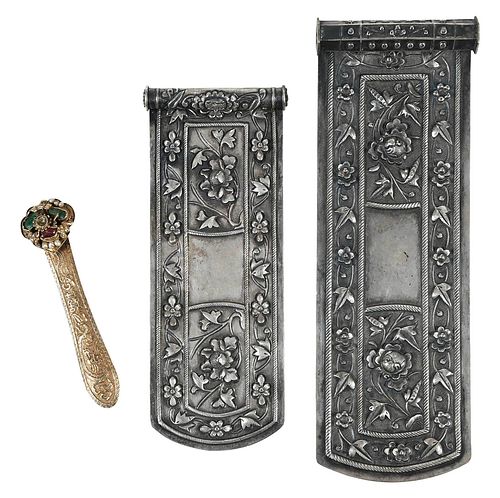Three Chinese Silver and Gold Plated Hair Ornaments
Bid Increments
| Price | Bid Increment |
|---|---|
| $0 | $25 |
| $100 | $50 |
| $1,000 | $100 |
| $2,000 | $200 |
| $3,000 | $250 |
| $5,000 | $500 |
| $10,000 | $1,000 |
| $20,000 | $2,000 |
| $50,000 | $5,000 |
| $100,000 | $10,000 |
late Qing dynasty, comprising: two silver hair ornaments, test 900 or better, floral and foliate decoration, stamped character marks verso, 5-3/4 x 2-1/8 in. and 8-3/8 x 2-1/4 in.; gold plated hair ornament with engraved dragon decoration, top with inset pearls, red, and green stones, stamped character mark verso, 3-1/2 in.
Note: Hairpins are an important symbol in Chinese culture, and are associated with many Chinese cultural traditions and customs. They were also used as everyday hair ornaments in ancient China; all Chinese women would wear a hairpin, regardless of their social rank. The materials, elaborateness of the hairpin's ornaments, and the design used to make the hairpins were markers of the wearer's social status. Hairpins could be made out of various materials, such as jade, gold, silver, ivory, bronze, bamboo, carved wood, tortoiseshell and bone, among others (wiki).
These examples come from a larger collection of period hair ornaments which are increasingly difficult to find.
Provenance: Private Collection, ColoradoCondition
scattered scratches, discoloration, and tarnish; gold plated piece missing some inset pearls/stones
Purchased items will be available for pick up or shipping from our Asheville, North Carolina auction facility within ten business days of the auction will be assessed a storage fee of $5.00 per day, per item. Purchaser agrees that packing and shipping is done at the purchaser's risk and that the purchaser will pay in advance all packing expenses, materials, carrier fees and insurance charges. At our discretion, items will either be packed by an agent such as a packaging store or Brunk Auctions. Please allow two weeks for shipping after payment is received. Shipment of large items is the responsibility of the purchaser. We are happy to provide names of carriers and shippers if a purchaser so requests. Brunk Auctions will have no liability for any loss or damage to shipped items.













